Bowl Season Is Coming. And There Are Only 36 Pylons Left.
As the holiday season nears, countless businesses, big and small, continue to tackle the challenges of a worldwide supply chain crisis. Inflation rates and shipping costs have skyrocketed as demand outpaces supply, exacerbated by swelling labor shortages and contracting transportation capacities amid the COVID-19 pandemic. Ports remain clogged with unloaded cargo freights. Consumers are projected to face shopping crunches on hot-ticket items like smartphones, sneakers and game systems.
And Neil Gilman is nearly out of pylons.
A 42-employee, two-factory operation in small-town Connecticut, Gilman Gear manufactures a wide range of football and other sporting equipment, including tackling dummies, blocking sleds and the first-down measuring sticks hup-hupped by chain crews on every NFL sideline. But, more than any other product, the company has cornered the market on corner markers: According to Gilman, some 9,000 high schools, roughly 90% of FBS programs and all 32 NFL teams—not to mention ESPN, whose Monday Night Football broadcasts feature “line-to-gain” pylon cameras—use Gilman Gear’s signature versions of those fluorescent, familiar-yet-forgettable cuboids.
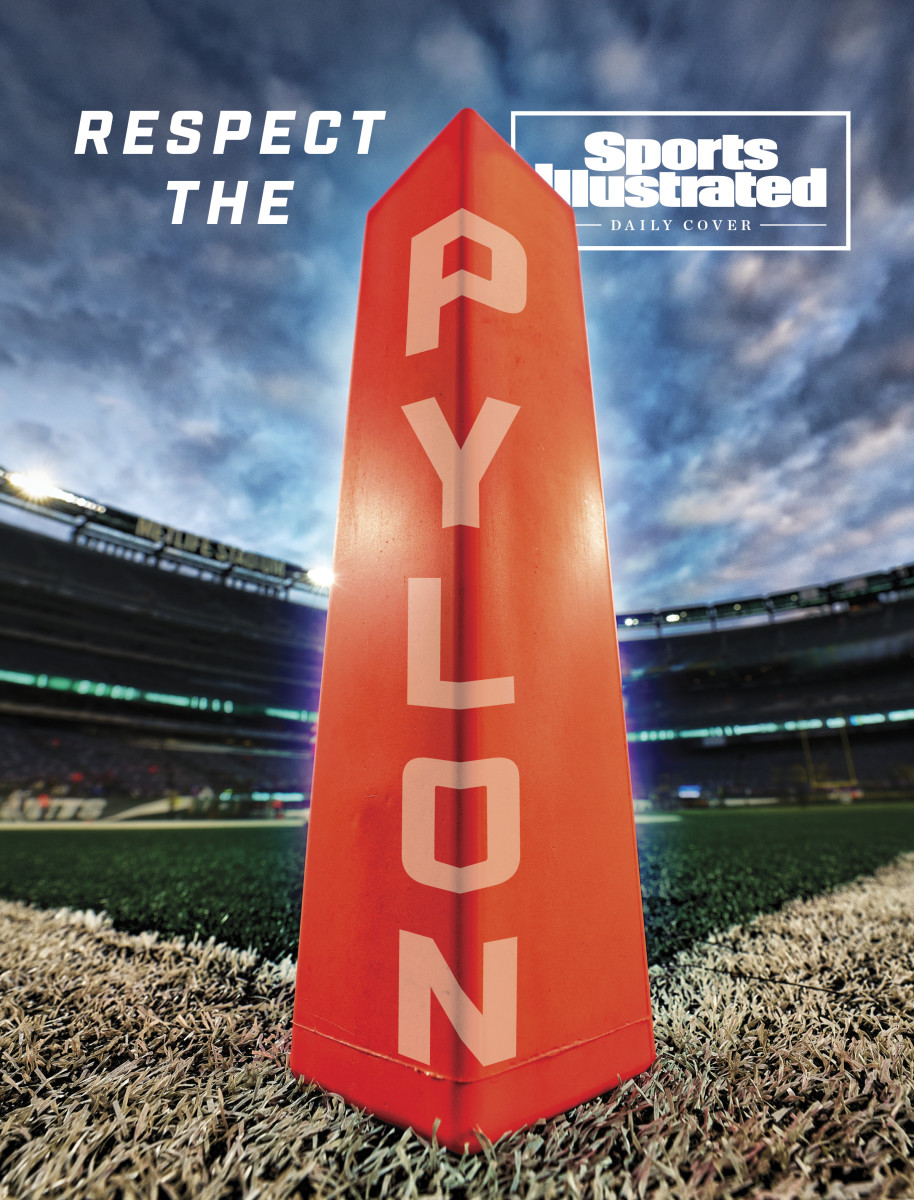
In past years, Gilman says, he always stocked at least 1,000 extra pylons in his inventory. By last week’s end, that supply had shriveled to a mere 36, packaged in six boxes of six. (It had been 48, but Gilman promised two boxes to the Rose Bowl.) The culprit? A widespread lack of a specific chemical agent required to create the foam material that forms Gilman’s pylons. “It’s on allocation, we’ve been waiting for it to arrive since August, and we won’t have it until January,” Gilman laments. “We’re running on fumes.”
A potential pylon shortage is far from the biggest problem facing an economy where even nonprofit aid organizations reliant on donations are suffering. Yet consider the unique cultural ramifications of such a scenario—the stakes for the stakes, if you will: “Every year the NFL buys a couple sets for the Super Bowl, and we put special emblems on them,” Gilman says. “Then there are a lot of bowl games that love the logo pylon. I thought about notifying key clients and telling them, We better fill that order right away, because we don’t know what the future holds.”
And so, while the pylon’s obituary isn’t quite ready to be penned, now perhaps seems as good a time as any to explore the story behind this 18-inch stick of stadium scenery—nicked, kicked, trampled, toppled and otherwise roughed up in the corners of end zones across the country every weekend—lest it is ever knocked down for good. “It’s ubiquitous; it’s part of the game,” Gilman says. “Just like you can’t play without goalposts, as far as the field is concerned, you can’t without pylons.”
Pylons come in many forms. They suspend bridges, support power lines and mark construction zones. There is the depressing William Faulkner novel set in fictionalized New Orleans about a love triangle of barnstorming pilots; the uplifting quartet of former art students from Georgia who formed what Slate dubbed “America’s best rock band”; and the subject of the disembodied, memeified electronic voice reminding StarCraft gamers to construct additional energy-mining Protoss towers. Derived from the Greek word for gate, they also form the towering stone entryways to ancient Egyptian temples, including at Karnak, where the sandstone walls just past its southernmost pylon are inscribed with etchings of King Horemheb traveling to seek treasure in the foreign land of Punt.
Punters, meanwhile, sometimes seek the pylon itself. “I take a look at it when I’m lining up, regardless of where I am on the field,” says the Packers’ Corey Bojorquez, whose 44.3-yard net average led the league through Week 10. Down in the coffin corner, pylons are akin to skinny orange headstones, popping out from the turf to provide a helpful point of reference—if they can be found. “For closer pooch punts I do like to aim towards the pylon, for sure,” Bojorquez explains. “Other than that it mostly blends in.”
For skill-position players, as with the Egyptians, pylons can mark a portal to a holy land. Stationed at the intersections of Sideline Street and Goal Line Drive—plus four along the end line—they are fodder for announcers looking to wring one last bit of drama out of a big run: Inside the 10 … inside the five … he’s at the pylon. … But unlike baseball’s foul pole, which paradoxically lives in fair territory, pylons are morally gray: According to the NFL rulebook, a loose ball that strikes a pylon is considered out of bounds; on the other hand, touchdowns are to be called if a ball in a player’s possession “passe[s] over or inside the pylon,” or if it “touches the pylon, provided that, after contact by an opponent, no part of the player’s body, except his hands or feet, struck the ground before the ball touched the pylon.”

In this way, pylons are something to strive for but not to dive for. Last January, less than two minutes before halftime in the AFC divisional round, Browns receiver Rashard Higgins stretched for the front-right pylon only to have the ball punched out by Chiefs safety Daniel Sorensen, resulting in a touchback for K.C. in Cleveland’s 22–17 loss. “Our rule there is not to reach the ball out when it is first-and-goal, and he knows that,” coach Kevin Stefanski later told reporters. “We have to fight that urge because it is such a big loss if it does end up being a touchback.”
As Borjoquez noted, though, pylons are easily overlooked, dwarfed in both physical stature and clout by equipmental cousins like measuring sticks and goal posts. In fact, they only regularly enter the action when they are dislodged from their usual perch. Most commonly this occurs in the form of a pylon dive, a universally thrilling moment that has spawned at least five YouTube compilations. But every so often pylons are also tapped as props, as when then Bengals star Chad Johnson grabbed a pylon and famously performed his best Tiger Woods imitation after snagging a 54-yard score over the Ravens in November 2005. “I just wanted to show my putting skills,” said Johnson, whose exhibition earned national headlines and a $5,000 fine.
Where Johnson was known for premeditated celebratory choreography, former Niners quarterback Nick Mullens’ big pylon moment was more off-the-cuff. “We were playing the Jets [in September 2020], we scored, and I noticed the pylon was knocked over,” Mullens says. “I was like, ‘I’ll mess around and set the pylon back up, take a job off the referees.’ I set it where it was supposed to go. Didn’t think much of it.”
That is, until Mullens returned to the visiting locker room in East Rutherford, N.J., after San Francisco’s 31–13 victory and found raised eyebrows waiting for him. “Some guys were like, ‘Did you really pick up the pylon?’ ” Mullens recalls. Even coach Kyle Shanahan joined the pile-on, calling out Mullens as the Niners broke down game film the following day. “He said, ‘You're such a nerd!’ ” Mullens recalls.
The next week, facing the Giants on the same field, Mullens handed off to Jerrick McKinnon and watched as the running back flattened the left pylon on a 10-yard score. “[Receiver Mohamed] Sanu thought it was funny from the week prior, so he was like, ‘Come here, come here!’ So I slowly, dramatically, fixed the pylon again.” At that moment, a personal brand was born. “It became a fun joke running through the locker room,” Mullens adds. “Anytime we got close to one in practice, someone would go, ‘Respect the pylon!’ ”
Looking back, Mullens figures it was the first time he’d ever touched a pylon as a pro. “Maybe back in high school I fell on one, but I haven’t had a diving, hit-the-pylon touchdown,” he says. “It was a lot heavier than people might think.” Still he will happily preach the gospel of the pylon, both from entertainment and practical perspectives. “I think the pylon cam is cool for fans,” says Mullens, now a backup for the Browns. “For runners approaching the end zone, I think they’re totally necessary. I don’t know if everybody would notice if the pylons weren’t set up correctly, but I think I would.”
As a professed pylo-maniac, Mullens is hardly alone. Last offseason, the 26-year-old received a message from an on-field security employee in San Francisco who had procured a game-used pylon and wanted Mullens to autograph it. A few days later, the pylon arrived on Mullens’ doorstep. Naturally, Mullens recalls, “I signed it GO NINERS, and wrote, RESPECT THE PYLON.”
Not counting a fleeting service team of World War II airmen dubbed the Wright-Patterson Pylons, the first documented appearance of football pylons occurred in 1962 at the inaugural Hall of Fame Game in Canton, Ohio. (The set that was used now resides in the museum’s collection.) Three years later, Big Ten officials unanimously voted to adopt the pylon and replace the old boundary-defining method of mini red flags, which had inspired not only the colloquial term “flag route” but controversy too. As one columnist wrote, “[T]hese 18-by-18-inch markers probably have produced as many perplexing problems for officials and provoked as many boos from the stands as anything connected with the game.”
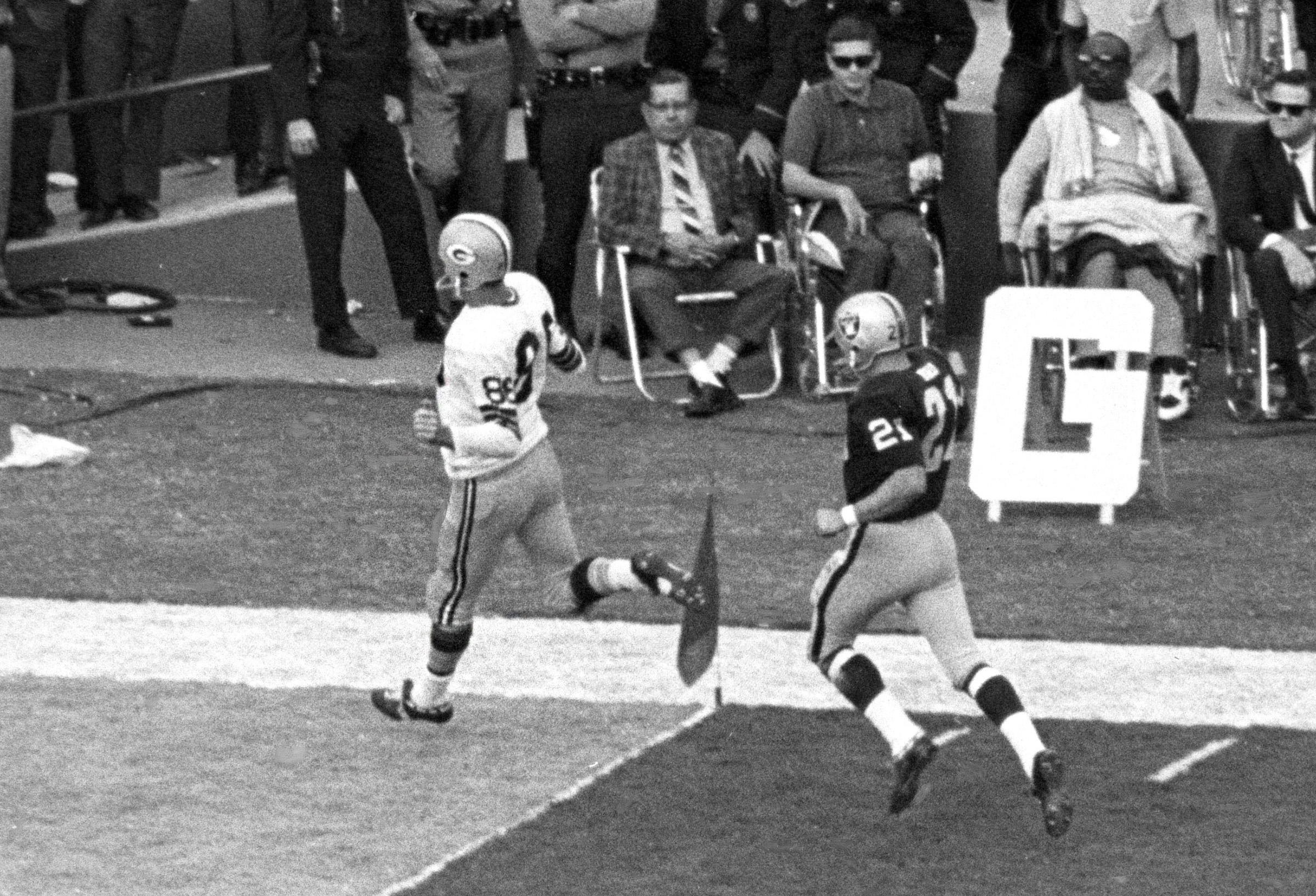
Although historical sources are sparse, credit for inventing the pylon generally goes to the late Irwin “Bud” Shopbell, a former high school and Big Ten official who lived fewer than five miles from the Pro Football Hall of Fame. In March 1968, Shopbell successfully filed for U.S. Patent No. 3,371,647, the abstract for which described “a corner marker for football fields and the like comprising a pliable, flexible post of foam-rubber-like material” bonded to a rubber base plate and stuck in a socket in the ground. In addition to “weird problems for game officials” caused by the flags “blowing into the field of play” on windy days, Shopbell also cited safety concerns—“the danger to players who may accidentally fall upon or be thrown upon one of the steel flag staffs”—as inspiration for his groundbreaking invention.
As usual, the NFL took longer before embracing the change for good: It wasn’t until Super Bowl VII, in Jan. 1973, that pylons first appeared in lieu of flags, though they quickly snagged the spotlight when Dolphins receiver Howard Twilley dragged a Washington defender into the end zone for the game’s first score, bowling over the front-right pylon in the process. And another two years passed before pylons were standardized leaguewide by way of a March 1975 owners’ meeting in Honolulu, with the “Playing Field” section of the rulebook changing to call for “pylons mounted on flexible shafts” instead of flags.
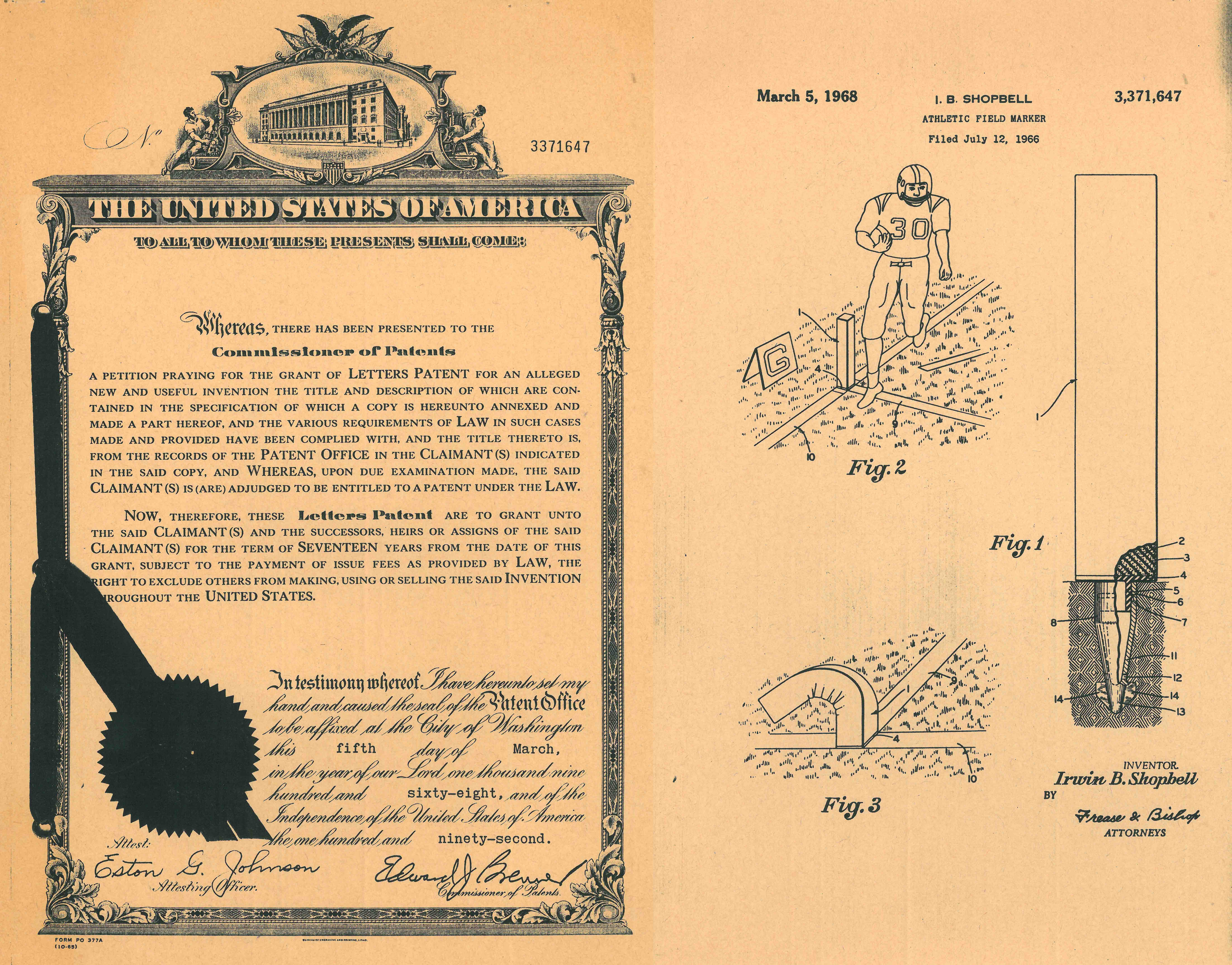
In the five decades since, pylons have undergone several notable technological innovations. The weighted pylon was born in the early ’90s, replacing the old spring-coiled version with a bottom-heavy foam mold that stood by itself rather than stick in the ground. Next came Gilman Gear’s logo-embossed pylon, which debuted for Super Bowl XLIII in Tampa, followed by the hyped pylon cam in 2012 that Gilman produced at the request of NFL Films to fiery results. “We machined out the inside of a pylon and glued in the camera,” Gilman says. “It was kind of primitive. They found that the camera generated a lot of heat, and would burn out the inside, and you’d have a smoking pylon.”
Eventually, though, GIlman found the right formula with the aid of some ESPN engineers who created a ventilation system to cool the cameras inside the foam shell. “And now that’s become commonplace on ESPN, on CBS, on Fox, on NBC,” Gilman says. “We don’t have a monopoly on pylon cams, but every pylon cam you see is inserted into a Gilman pylon.” Finally, at the Worldwide Leader’s behest two years ago, Gilman unveiled the heftier line-to-gain pylon—weighing 8 ½ pounds, compared with 7 for end zone markers—containing a 45-degree, wide-angle lens for capturing close plays at the first-down sticks.
Still dangers remain for both pylon and player. A few months after the pylon cam debuted in the NFL, in November 2015, Bills running back LeSean McCoy shattered one while stretching for a touchdown against the Patriots. Then, in October 2017, Wake Forest freshman receiver Greg Dortch suffered a punctured small intestine on a similar play; the case was later written up in a sports medical journal—“Jejunal Perforation From Blunt Abdominal Trauma by an End Zone Pylon in a Division I Football Player”—that revealed Dortch had been left with a mark on his stomach “in the shape of the pylon.”
Fortunately Ezekiel Elliott avoided a similar fate when the Cowboys running back landed smack on the line-to-gain pylon in Week 5 on Monday night, resulting in little more than soreness—both in his spine and in postgame quotes. “That thing is kind of hard,” Elliott told reporters with a laugh. “Maybe they should find a new spot for it. … It kind of just stabbed me. Lost my wind.” (Elliott exacted revenge the next week, reportedly kicking an end zone camera pylon so hard that it snapped off its wired base.)
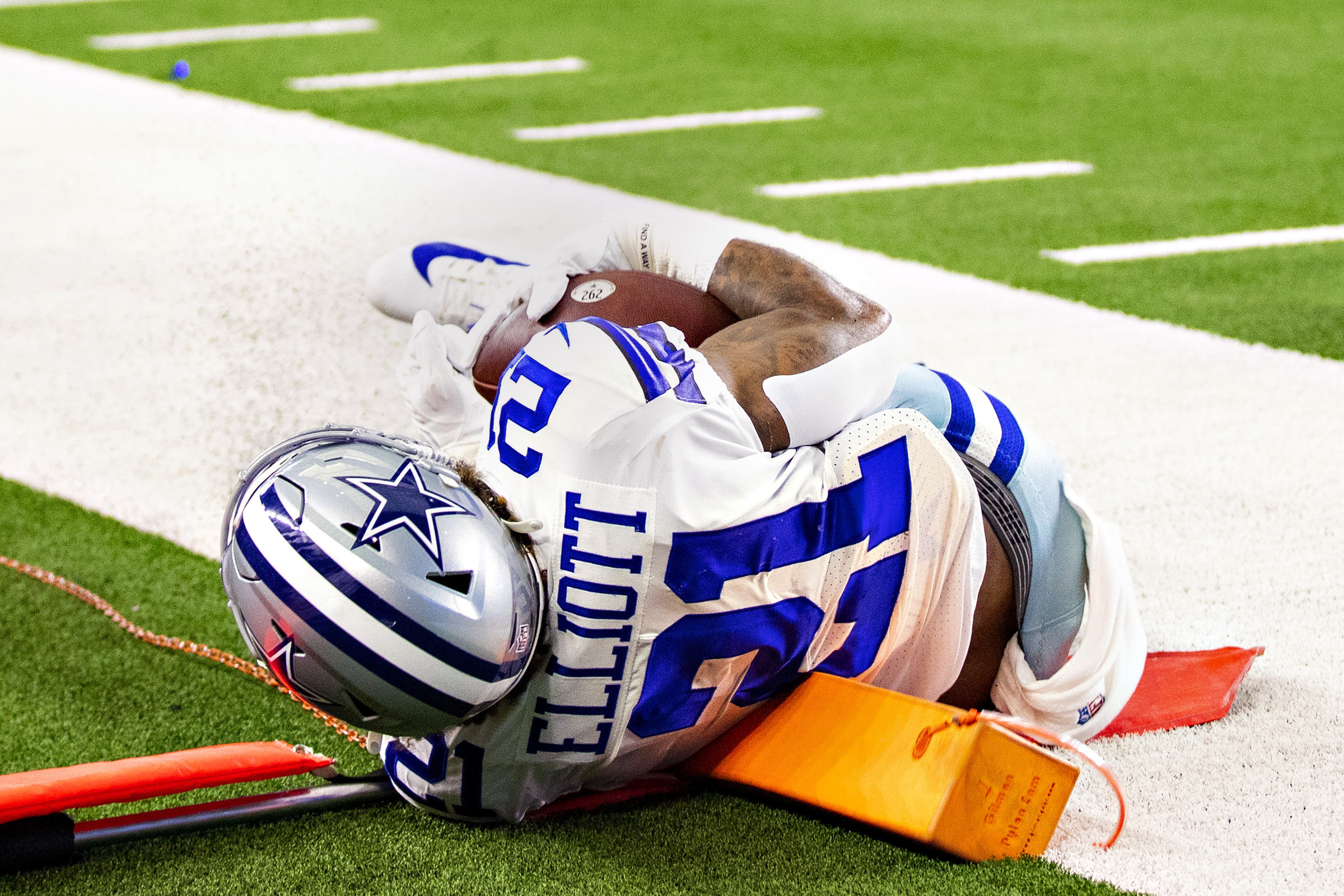
Soon after Elliott’s near injury, Gilman received a clip of the play from an ESPN producer, who wanted to know what the world’s foremost pylon manufacturer thought. “My response was, well, Ezekiel hit it just right,” Gilman says. “It’s kind of a freak accident. May never occur again. They asked if there was anything I could do to possibly make it safer, and I explained that if we make this high-density foam softer, when he falls on it, the camera core may pop out. We agreed we didn’t want that to happen.”
Besides, adds Gilman with a dash of defensiveness, “It’s not like the pylon jumped up and tackled him.”
Marty Gilman had a bright idea. This was the late 1920s, an era of football when helmets had no face masks, practices were full-contact, and every injury could be cured with a smear of dirt and some pushups. Then a senior at UConn, seeking to lessen the toll his body was taking, the elder Gilman found an empty canvas bag, stuffed it with woolen byproduct from his parents’ nearby textile mill and asked his coach whether the team could try hitting the sack instead of one another.
“The coach said, ‘I love it. Make me six more,’ ” his son Neil recounts. “That was the start.”
In addition to the tackling dummy, Marty Gilman, who died in 1979, went on to pioneer several practice-field mainstays, including blocking sleds and handheld shields. (He was also among the first to manufacture the slingshot goalpost, though the original specs were supplied by another inventor.) Eventually Neil joined the family business as an Ivy League freshman in ’73—“My joke is my parents sent me to Harvard so I could learn how to make dummies,” he says—the same year Gilman Gear began selling pylons to NFL teams. “I still remember them coming off the production line,” he says.

The process of making a pylon is simple enough. It starts with a custom-made, preheated steel mold, lubricated in Teflon like an oiled skillet. “When you make an egg, you want it to slide right off,” Gilman says. “Same with the foam in the tool.” From there a steel weight is inserted into the mold and steadied an inch from the bottom, “so it’s not going to stick out. Then we have a machine that calibrates the foam and dispenses it through a special orifice. After we pour it, we plug the orifice, let it cure for like 15 minutes at a certain temperature, pop it out using an air extraction technique, trim it and it’s done.”
Two key tweaks, implemented one year apart in the early 1990s, helped refine the pylons that populate most end zones today. The first was the formulation of an “integral-skin” foam—also known as “self-skinning” foam—that creates a quarter-inch, smooth-and-shiny layer of protection around the surface. “It’s perfect for these pylons, because you don’t want to put a cover on them,” Gilman says. The other: When Gilman Gear first made its integral-skin pylons, it did so with the same red foam that formed its blocking sled pads. “We quickly realized that wasn’t going to work for the end zone,” Gilman says. “So we developed the chemistry to put an orange pigment [021 C on the Pantone Matching System] in the foam. So if you slice the foam in half, it’s orange all the way through.”
Here is where the supply chain crisis comes into play. While Gilman Gear sources its foam from a U.S. company, Honeywell, that mixture in turn requires a Chinese-made “blowing agent” called Solstice, which causes the foam to expand and fill the mold, similar to yeast in bread. “Without Solstice, you can’t really use that foam system,” Gilman says. “So we had to start looking for an alternative. If we didn’t come up with one, I’d say that the world’s best pylon would be temporarily out of stock.”
After two months of meticulous research—not to mention much fretting over unfilled backorders placed by high-profile clients—the solution to Gilman’s problem finally arrived at his factories this week, in the form of a dozen 55-gallon drums of a new foam mixture with a new blowing agent produced by a St. Louis company. At first Gilman was uncertain how the foam would perform inside his machinery, but it aced its test run Tuesday, just in time to resume production Thursday. “Everything in stock was exhausted,” Gilman says. “We expect to make 450 pylons in the next three weeks.”
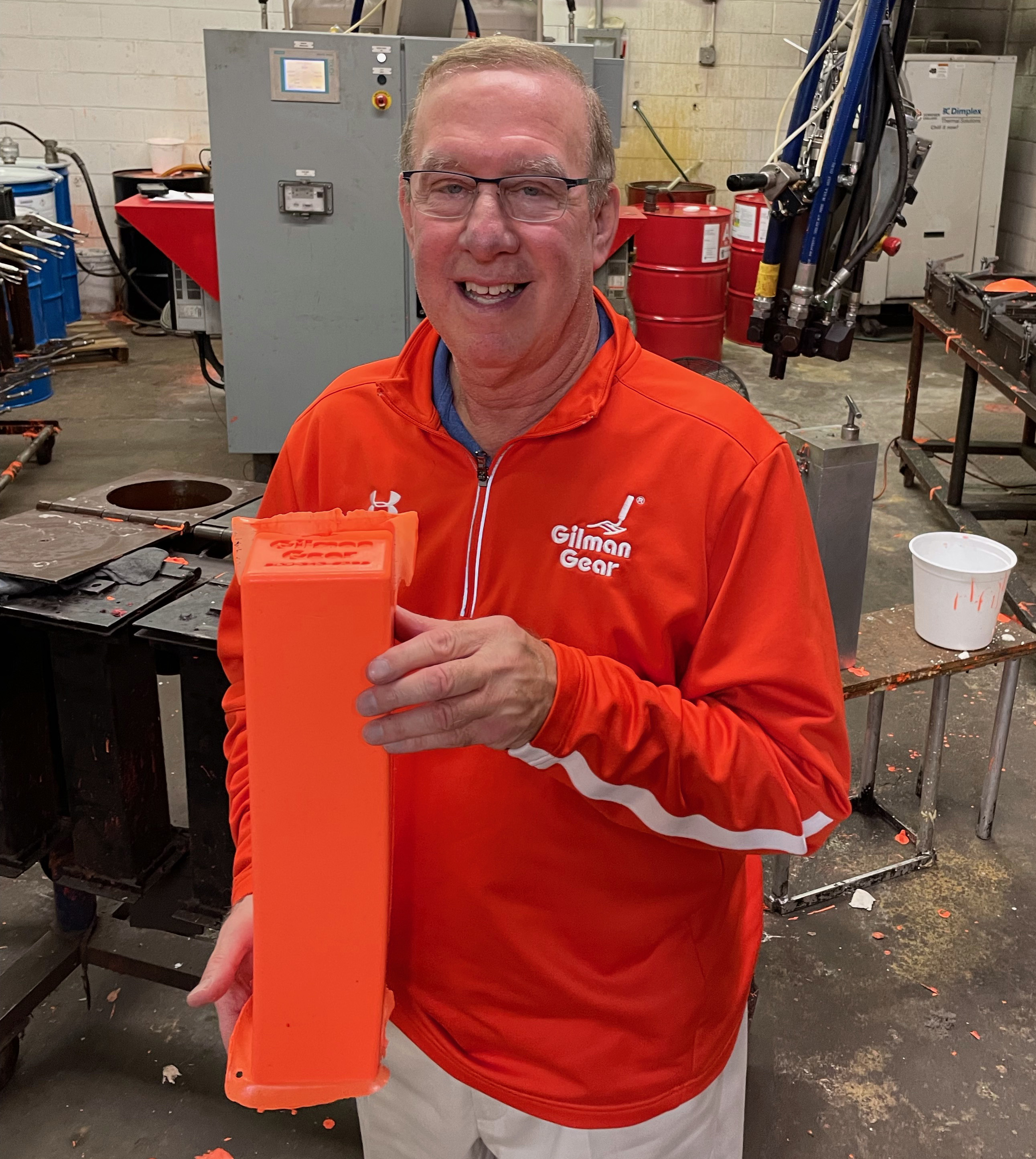
As the 66-year-old Gilman speaks over the phone, it is clear that pylons aren’t just a professional pursuit—they are a passion, too. Every morning he scours the three newspapers that land on his doorstep for pictures of players stretching past them for touchdowns. “Nine times out of 10 it’s a Gilman pylon,” he says. “I always cut out the picture and save it in a scrapbook.” He also attends games in person whenever possible, trawling the sidelines during warmups to inspect the fruits of his family’s work, occasionally smarting when he comes across a pylon that has been nudged off its proper spot.
“I’m very sensitive to their placement,” Gilman says. “They’re kind of like my children.”
If nothing else, he figures, it’s a matter of respect.
Read more of SI's Daily Cover stories here:
• How a QB Evolution Sparked a Coaching Revolution
• How Does Dan Campbell Create a Winning Culture While Losing?
• How Steelers' Logo Helped Heal Pittsburgh After Synagogue Shooting
• The Mystery and Controversy of the Original Rams Helmet
